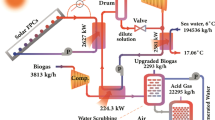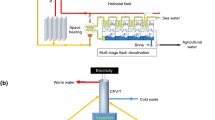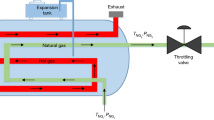Abstract
The present study focuses on the detailed technical and cost-effective feasibility analyses of a 60 MWe steam power plant integrated with parabolic trough solar collectors. Aluminum oxide (Al2O3) nanoparticles are mixed with thermal oil to be used as a heat transfer fluid in the collector loops. The electric power is generated using steam Rankine cycle. For this purpose, the steam turbine of 60 MWe production capability of Teknecik power plant located in Northern Cyprus has been analyzed and an integrated solar steam turbine system is presented which generates electric power. Detailed energy and exergy assessment of the solar thermal plant is carried out. The important parameters are examined including overall energy and exergy efficiencies, exergy destruction rate and system performance by varying direct normal irradiation (DNI), mass flow rate of the collector, ambient and inlet temperatures. Furthermore, thermal power available from the solar field at various solar multiples is assessed, and levelized energy cost has been calculated. Results show that turbines are the main source of exergy destruction (63855 kW) followed by feedwater heaters and boiler. Overall energetic and exergetic efficiencies of the system are observed to be 22.64 and 23.83%, respectively. The integration of PTC system with conventional plant results in a reduction in fuel consumption which significantly brings down the CO2 emissions by almost 33%.



















Similar content being viewed by others
Abbreviations
- A ap :
-
Aperture area (m2)
- A r :
-
Receiver area (m2)
- A c :
-
Collector area (m2)
- C:
-
Concentration ratio
- C p :
-
Specific heat capacity (kJ/kg K)
- D:
-
Diameter (m)
- \(\dot{E}x\) :
-
Exergy rate (kW)
- F R :
-
Heat removal factor
- G b :
-
Intensity of direct irradiation (W/m2)
- h c, ca :
-
Convective heat transfer coefficient from glass cover to ambient (W/m2 K)
- h r, ca :
-
Radiation heat transfer coefficient between ambient and cover (W/m2 K)
- h r, cr :
-
Coefficient of radiation heat transfer between cover and receiver (W/m2 K)
- \(\kappa_{\gamma }\) :
-
Incidence angle modifier
- k :
-
Thermal conductivity, (W/m K)
- \(\dot{m}\) :
-
Mass flow rate (kg/s)
- N u :
-
Nusselt number
- P r :
-
Prandtl number
- \(\dot{Q}\) :
-
Thermal energy produced (kW)
- R e :
-
Reynolds number
- S :
-
Radiations absorbed by receiver (W/m2)
- T c :
-
Glass cover temperature (K)
- T r,av :
-
Receiver average temperature (K)
- T a = T 0 :
-
Ambient temperature (K)
- T S :
-
Sun Temperature (K)
- U L :
-
Overall heat loss coefficient of solar collector (W/m2K)
- \(\dot{W}\) :
-
Electricity/network output (kW)
- ann:
-
Annual
- bf:
-
Base fluid
- b:
-
Boiler
- con:
-
Condenser
- c:
-
Cover
- col:
-
Collector
- en:
-
Energy
- ex:
-
Exergy
- hpt:
-
High pressure turbine
- Issp:
-
Integrated solar steam turbine generation plant
- In:
-
Inlet
- i:
-
Inner
- incr:
-
Incremental
- invest:
-
Investment
- lpt:
-
Low pressure turbine
- nf:
-
Nanofluid
- np:
-
Nanoparticle
- ov:
-
Overall
- o:
-
Outer
- O and M:
-
Operation and maintenance
- Ref:
-
Reference
- r:
-
Receiver
- s:
-
Sun
- sur:
-
Surface
- st:
-
Steam
- Sp:
-
Steam turbine plant
- th:
-
Thermal
- U:
-
Utilization
- \(\alpha\) :
-
Absorbance of receiver
- \(\gamma\) :
-
Intercept factor
- \(\epsilon\) :
-
Emissivity
- \(\eta\) :
-
Efficiency
- \(\theta\) :
-
Incident angle, degrees
- \(\mu\) :
-
Dynamic viscosity, (Pa s)
- \(\rho\) :
-
Reflectance of mirror
- \(\dot{\rho }\) :
-
Density (kg/m3)
- \(\sigma\) :
-
Stefan-Boltzmann constant (W/m2-K4)
- \(\tau\) :
-
Transmittance of glass cover
- \(\varphi\) :
-
Percentage of nanoparticles
- ASS:
-
Annual solar share
- Al2O3 :
-
Aluminum oxide
- CFWH:
-
Closed feedwater heater
- DNI:
-
Direct normal irradiation
- HTF:
-
Heat transfer fluid
- LEC:
-
Levelized electricity cost
- OFWH:
-
Open feedwater heater
- PTC:
-
Parabolic trough collector
- SM:
-
Solar multiple
References
Abid M, Ratlamwala TAH, Atikol U (2016) Performance assessment of parabolic dish and parabolic trough solar thermal power plant using nanofluids and molten salts. Int J Energy Res 40:550–563
Al- Sulaiman FA (2014) Exergy analysis of parabolic trough solar collectors integrated with combined steam and organic Rankine cycles. Energy Convers Manag 77:441–449
Aljundi IH (2009) Energy and exergy analysis of a steam power plant in Jordan. Appl Therm Eng 29:324–328
Alrobaei H (2008) Novel integrated gas turbine solar cogeneration power plant. Desalination 220:574–587
Bakos G, Adamopoulos D, Tsagas N, Soursos DM (1999) Design and construction of a line-focus parabolic trough solar concentrator for electricity generation. In: Proceedings of ISES solar world congress, Jerusalem
Bakos GC, Ioannidis I, Tsagas NF, Seftelis I (2001) Design optimization and conversion-efficiency determination of a line-focus parabolic-trough solar collector (PTC). Appl Energy 68:43–50
Basrawi F, Yamada T, Obara SY (2014) Economic and environmental based operation strategies of a hybrid photovoltaic–micro gas turbine tri generation system. Appl Energy 121:174–183
Batchelor GK (1977) The effect of Brownian motion on the bulk stress in a suspension of spherical particles. J Fluid Mech 83:97e117
Bellos E, Tzivanidis C, Antonopoulos KA, Gkinis G (2016a) Thermal enhancement of solar parabolic trough collectors by using nanofluids and converging-diverging absorber tube. Renewable Energy 94:213–222
Bellos E, Tzivanidis C, Antonopoulos KA, Daniil I (2016b) The use of gas working fluids in parabolic trough collectors—An energetic and exergetic analysis. Appl Therm Eng 109:1–14
Cheng Z (2014) HeY, CuiF, Du B, Zheng Z, Xu Y. Comparative and sensitive analysis for parabolic trough solar collectors with a detailed Monte Carlo ray-tracing optical model. Appl Energy 115:559–572
Cohen G, Kearney D (1994) Improved parabolic trough solar electric system based on the SEGS experience. In: Proceeding of the ASES annual conference, SOLAR 94, pp 147–150
Duffie J, Beckman W (2006) Solar engineering of thermal processes. Wiley, Hoboken
Eter AA (2011) Modeling and optimization of a hybrid solar combined cycle (HYCS), Master’s thesis, King Fahd University of Petroleum and Minerals, Saudi Arabia
Frank Incropera P, David Dewitt P, Theodore Bergman L, Adrienne Lavine S (2006) Fundamentals of mass and heat transfer, 6th edn. Wiley, Hoboken
Gupta MK, Kaushik SC (2008) Exergetic performance evaluation and parametric studies of solar air heater. Energy 33(11):1691–1702
Gupta MK, Kaushik SC (2010) Exergy analysis and investigation for various feed water heaters of direct steam generation solar–thermal power plant. Renewable Energy 35:1228–1235
Hasan NM, Abbas NA, Goudarzi A, Valizadeh M, Samadian P (2014) Cogeneration solar system using thermoelectric module and fresnel lens. Energy Convers Manage 84:305–310
Huang FF (1990) Performance evaluation of selected combustion gas turbine cogeneration systems based on first and second- law analysis. J Eng Gas Turbines Power 112:117–121
Kalogirou S (2009) Solar energy engineering: processes and systems. Elsevier, Amsterdam
Kaushik SC, Singhal MK, Tyagi SK (2001) Solar Collector Technologies for Power Generation and Space Air Conditioning Applications: A State of the Art, Internal Report, CES. Indian Institute of Technology: Delhi, India
Leinhard J IV, Leinhard V (2012a) A heat transfer textbook, 4th edn. Philogiston Press, USA, pp 354–360
Leinhard J IV, Leinhard JV (2012b) A heat transfer textbook, 4th edn. Philogiston Press, Cambridge, p 354e360
Lippke F (1996) Direct steam generation in parabolic trough solar power plants: numerical investigation of the transients and the control of a once-through system. J Sol Energy Eng 118:9–14
Luz International Limited (1990) Solar electric generating system IX technical description. Luz International Limited, Jerusalem
Maxwell JC (1881) A treatise on electricity and magnetism, 2nd edn. Clarendon Press, Oxford, UK
Montes M, Abánades A, Martinez-Val J, Valdés M (2009) Solar multiple optimization for a solar-only thermal power plant, using oil as heat transfer fluid in the parabolic trough collectors. Sol Energy 83:2165–2176
Montes M, Rovira A, Munoz M, Martinez-Val J (2011) Performance analysis of an integrated solar combined cycle using direct steam generation in parabolic trough collectors. Appl Energy 88:3228–3238
NREL (2003) Heat transfer analysis and modeling of a parabolic trough solar receiver implemented in EES. NREL, Golden
Pearce JM (2009) Expanding photovoltaic penetration with residential distributed generation from hybrid solar photo voltaic and combined heat and power systems. Energy 34:1947–1954
Poullikkas A (2009) Economic analysis of power generation from parabolic trough solar thermal plants for Mediterranean region-A case study for the island of Cyprus. Renew Sustain Energy Rev 13:2474–2484
Raj NT, Iniyan S, Goic R (2011) A review of renewable energy based cogeneration technologies. Renew Sustain Energy Rev 15:3640–3648
Ratlamwala TAH, Dincer I, Aydin M (2012) Energy, exergy analyses and optimization study of an integrated solar heliostat field system for hydrogen production. Int J Hydrogen Energy 37:18704–18712
Ratlamwala TAH, Dincer I, Gadalla MA (2013) Energy and exergy analyses of an integrated solar based desalination quadruple effect absorption system for fresh water and cooling production. Int J Energy Res 37:1569–1579
Rheinlander J, Lippke F (1998) Electricity and potable water from a solar tower power plant. Renewable Energy 14:23–28
Wang P, Liu D (2013) XuC. Numerical study of heat transfer enhancement in the receiver tube of direct steam generation with parabolic trough by inserting metal foams. Appl Energy 102:449–460
Wu Y, Rosen MA (1999) Assessing and optimizing the economic and environmental impacts of cogeneration/district energy systems using an energy equilibrium model. Appl Energy 62:141–154
Yu W, Choi SUS (2004) The role of interfacial layers in the enhanced thermal conductivity of nanofluids: a renovated Hamilton-Crosser model. J Nanoparticle Res 6(4):355e361
Zarza E, Rojas ME, Gonzalez L, Caballero JM, Rueda F (2006) INDITEP: the first pre-commercial DSG solar power plant. Sol Energy 80:1270–1276
Author information
Authors and Affiliations
Corresponding author
Rights and permissions
About this article
Cite this article
Khan, M.S., Abid, M. & Ratlamwala, T.A.H. Energy, Exergy and Economic Feasibility Analyses of a 60 MW Conventional Steam Power Plant Integrated with Parabolic Trough Solar Collectors Using Nanofluids. Iran J Sci Technol Trans Mech Eng 43 (Suppl 1), 193–209 (2019). https://doi.org/10.1007/s40997-018-0149-x
Received:
Accepted:
Published:
Issue Date:
DOI: https://doi.org/10.1007/s40997-018-0149-x




